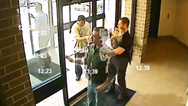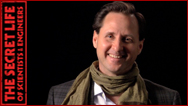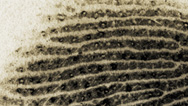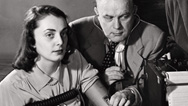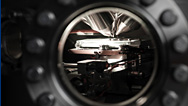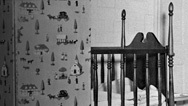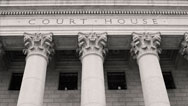
Manhunt—Boston Bombers
Which technologies worked—and which didn't—in the race to track down the men behind the marathon attack? Airing May 29, 2013 at 9 pm on PBS Aired May 29, 2013 on PBS
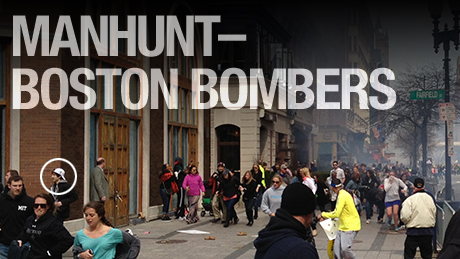
Program Description
Transcript
NARRATOR:A perfect day turns deadly.
The Boston Marathon bombing: investigators go into high gear to find the suspects, but there's a twist. It's a new age of counterterrorism technology, with electronic eyes on the streets,â¦
SUPERINTENDENT WILLIAM "BILL" B. EVANS (Boston Police Department): We knew we'd get good video.
NARRATOR:â¦and in the skiesâ¦
KEVIN TUCKER (FLIR Systems, Inc.): You can't fool a thermal picture.
NARRATOR:â¦and computers that build facesâ¦
MARIOS SAVVIDES (Carnegie Mellon University): The computer has to hallucinate.
NARRATOR:â¦new tools in the detectives' arsenal.
There's an avalanche of evidence.
VAN ROMERO (New Mexico Institute of Mining and Technology): That white smoke, what does that mean?
NARRATOR:There's chemical evidence; there's visual evidence; a torrent of information: unfiltered, unedited and often wildly inaccurate.
MARIA CRAMER The Boston Globe): There was an information vacuum. People were filling it with bad information.
BILL EVANS:The F.B.I. didn't know who these suspects were.
NARRATOR:But somewhere, hidden in the chaos, are crucial clues. Can technology help investigators find the truth and track down the perpetrators?
MAN:They have explosives!
HADLEY SOLOMON (Watertown Resident): It was terrifying. We were shaking.
NARRATOR:Manhunt—Boston Bombers, right now, on NOVA.
It is marathon day in Boston.
BILL EVANS:I went off in the first wave up there, and it was a beautiful day.
NARRATOR:The weather is perfect.
BILL EVANS:It's a special day, you know? The atmosphere is just electric.
NARRATOR:Thousands line the streets, enjoying the city's most celebrated sporting event; among the runners, heading for the finish line, in his 44th marathon, Boston Police Superintendent Bill Evans.
BILL EVANS:I felt great. When I get into Boston, I'm saying hi to all my fellow officers on the route. The ironic thing was the bomb squad was right there with a dog, right at the finish line, when I finished. So, that's something I remember, given the way the events of the day turned out.
NARRATOR:An hour later, the unimaginable happens. Two bombs explode within seconds, killing three and injuring hundreds. Almost immediately, the manhunt begins.
Investigators will push the limits of technology with new tools, such as facial recognition, thermal imaging and bomb analysis.
The clock is ticking. Can they get the bombers before they strike again?
DISPATCHER: This vehicle might be heading towards New York.
MAN:There's got to be people hurt out there.
MAN:We need help!
MAN:Oh, my god.
NARRATOR:In the minutes after the bombing, first responders rush to help.
RADIO: All units stay off the air and make your way over there.
Get as many people up here as you can from the medical tent.
NEWSCASTER:We've just gotten word of not one but two explosions at the Boston Marathon. These are live pictures just coming in.
NARRATOR:The horror plays out in real time on TV and social media.
NEWSCASTER:We are all, in Boston, immersed in a chaotic scene.
NEWSCASTER:Things developing very quickly now. These two explosions were heard near the finish line.
NEWSCASTER:We just want to warn viewers that this is raw video, just coming into the newsroom, and we feel it's important to get it out there.
NARRATOR:The police and medics are rushing toward the danger of more explosions, just as many of them were trained to do, by this man, Van Romero, one of the world's leading experts on explosives.
He watches with the heart of a friend and the mind of a scientist.
VAN ROMERO:It's almost schizophrenic, from my standpoint, isâ¦part of my brain is going into analysis mode: "Whatâ¦that white smoke, what does that mean?"
I started looking for broken windows. That tells me where the pressure rate was and how big the pressure rate was. Is there a crater? All that analytical stuff is going through the brain.
At the same time, we know the people that are responding. They come here, they become our friends. We know how dangerous it is. It is emotional to watch those guys do their job.
NARRATOR:Romero heads research at New Mexico Tech University in Socorro. The school operates the most active explosives testing facility in the U.S. Every workday, at least two or three explosions echo across 40 square miles of barren desert canyons here.
It began as, and remains, a favorite place for weapons makers to measure the menace of missiles and ordnance. But in the age of terrorism, a new kind of client has beaten a path to Socorro.
Name a crime of terror—Oklahoma City, the first attack on the World Trade Center or the London Transit Bombings—after each attack, investigators have come here, to test their notions of what happened, as they build a legal case.
VAN ROMERO:When you look at the scene of a terrorist bomb, it's just a mess. The important role that we play is, how do we put the pieces of the puzzle together, so that we know they fit?
NARRATOR:But solving the puzzle and saving lives are often at odds.
VAN ROMERO:They have to rescue people, stabilize the area and make sure they're safe, but also, hopefully, protect the forensic evidence that's left behind.
NARRATOR:For Romero, the first clue is the smoke. It is white, a surefire sign of a gunpowder explosion. It means the devices are likely homemade. He wonders if they could be pressure-cooker bombs.
VAN ROMERO:Pressure cookers aren't as common or they weren't as common, here, in the United States, although they are common in the Middle East.
NARRATOR:Pressure-cooker bombs are a tried and true instrument of terror, globally. In 2006, Islamic terrorists set off seven of them in 11 minutes, on crowded commuter trains, in Mumbai, India, killing more than 200.
So what is a pressure-cooker bomb? It starts with something you might have in your kitchen.
VAN ROMERO:This is a pressure cooker that you would have in your home.
NARRATOR:It is distressingly simple to build. The ingredients for the bomb are cheap and easily available: gunpowder and shrapnel, in this case some nuts, still in their packaging.
The tightly sealed pot cooks food faster, but when gunpowder is ignited inside, it will burst.
Ignition is the only complicated step. They didn't share that with us, but a simple how-to is not hard to find.
So, could an amateur build and detonate two of these bombs almost at once, without any training?
VAN ROMERO:The fact that they were two for two, kind of indicates to me that it was a little bit more than luck. And the fact that they were so close together—10 seconds, 10 to 15 seconds away is essentially simultaneous—to me it indicates some level of sophistication.
NARRATOR:The team here in New Mexico has that sophistication. When their bomb is ready, the warning siren sounds, and they retreat to a bunker high above the site, almost half a mile away.
MAN:Standby for camp. Five, four, three, two, oneâ¦boom.
VAN ROMERO:So, you can see the smoke that came off is exactly what you saw in Boston.
NARRATOR:The explosions are strikingly similar.
What can investigators learn by seeing the explosion in slow motion? Here, at New Mexico Tech, they can do that with high-definition, high-speed cameras, at 6,200 frames a second, allowing the experts to examine, in forensic detail, how the bomb explodes.
MICHAEL J. HARGATHER (New Mexico Institute of Mining and Technology): If we step through this video, what Mike was pointing out was, first, we get this jet coming right out the top of the pressure cooker.
VAN ROMERO:It fails, right where the top seals into the pot.
MICHAEL J. STANLEY (New Mexico Institute of Mining and Technology): You can actually see the flame in between where the latches were on the cooker.
NARRATOR:Placing the pressure cooker on its side directs the shrapnel closer to the ground, making it more likely to cause serious injuries.
MIKE STANLEY:So when the lid let go, the pressure cooker opened up and split apart and launched everything backwards.
VAN ROMERO:It peeled like a banana as it came out.
NARRATOR:These pieces are the walls of the pressure cooker.
The replay also allows the experts to determine the speed of the fragments.
MIKE HARGATHER: It's moved almost seven pixels, and so, at our pixel resolution of six millimeters per pixel, that's about 270 meters per second.
VAN ROMERO:Not quite the speed of sound, but it's moving pretty good.
NARRATOR:By observing how fast shrapnel flies apart, forensics experts like these can gauge the size and power of an individual bomb. That's a valuable piece of information for investigators in Boston, who, at this point, still aren't sure what kind of device was used.
With the injured evacuated, the forensic work begins in earnest. The F.B.I., A.T.F. and other federal agencies join the Boston Police Department and the Massachusetts State Police in the hunt for the bombers. It starts with a search for fragments of the bombs.
This is exactly what they're taught to do here in New Mexico, where Van Romero leads a team of students to sweep the area. Walking shoulder to shoulder, they pick up everything they can find.
VAN ROMERO:Here's the lid from the pressure cooker. This is going to be a really important piece of forensic evidence. Okay, this was part of the device. Now that I know that part of the device, I can analyze this metal and figure out what the brand, the model, the make of the pressure cooker; where the metal was forged, where this thing was manufactured. And then, as I collect other fragments, I want to make sure that they match the origin of this piece here.
MIKE STANLEY:I'll dump some of these out, so that we can take a look.
NARRATOR:In the lab, engineer Mike Stanley combs through the fragments.
MIKE STANLEY:Even though you have a detonation, all of the pieces are still there; they've just been separated. So, with enough time and enough diligence, you could actually put that entire pressure cooker back together.
The evidence is all there, it's just in small pieces, and you have to find all of those pieces.
NARRATOR:In Boston, instead of nuts, they find BBs and nails scattered throughout the scene, the shrapnel from inside the bomb. And then, on the roof of a six-story hotel nearby, they find a lid.
It confirms Romero's hunch that the bombs were built from pressure cookers.
VAN ROMERO:You never stop, really, trying to understand what's going on at the scene. You have to make sure you've peeled back all the skin of the onion to understand what's going on.
NARRATOR:Police Superintendent Bill Evans, who, only 90 minutes before, finished running the Marathon, is now speeding back to Copley Square in his cruiser.
BILL EVANS:On the way there, the whole time, I was hoping that maybe it was a gas explosion or an electrical explosion. So, the whole way there I am saying, "It can't be bombs, it can't be. Please, don't let it be a bomb."
NARRATOR:When he arrives at the finish line, he has no doubt that he is now at the center of a horrific crime scene.
BILL EVANS:I had just run down the street probably an hour and a half before this, and it was such a festive occasion. Now, I had to look at the street and see those young victims still laying on the street and to see a window smashed. The barrier is blown out into the street, debris everywhere. It was surreal. It looked like something you would see over in Beirut or Israel. It was sad is what it was.
NARRATOR:Three are dead, dozens maimed. Bill Evans is now on duty, his great run on a beautiful day shattered by a dreaded nightmare.
In the chaos, his boss, Commissioner Ed Davis has no doubt about what needs to be done right away.
COMMISSIONER EDWARD F. DAVIS (Boston Police Department): We have a lieutenant here who does a lot of video collection for us, he happened to be right there as I arrived on the scene. So, I grabbed him, and I said, "Listen, first job here, get on the video; start to pull videos from all the locations, and let's start looking at it. And so, within 10 minutes of the blast, we had detectives that were already out pulling video.
BILL EVANS:If you know Boylston Street, there is, basically, 200 businesses and stores on that street, so we knew we'd get good video.
NARRATOR:Detectives must go door to door, hunting for visual evidence, since the cameras are privately owned and individually monitored. Boston has only a limited number of cameras, and there is nothing tying them together. Each video will have to be collected and viewed separately, a laborious and time-consuming process.
But what if the cameras could all be watched in real time at a central location? Amazingly, today, there is only one city where this is known to be possible.
MAN:This is the executive command center.
NARRATOR:When it comes to technology, Police Commissioner Ray Kelly is a true believer and an early adopter.
COMMISSIONER RAYMOND KELLY (New York City Police Department): We're big fans of cameras here. It's been a tremendous force multiplier, if you will, for law enforcement.
NARRATOR:The city's ambitious effort to connect and monitor thousands of surveillance cameras has never been tried before. The result is called the Domain Awareness System.
JESSICA TISCH (New York City Police Department):This is the state of the art. It is the most sophisticated camera system that you'll see, across the world.
NARRATOR:Domain Awareness takes in a steady stream of data from license plate readers, environmental sensors and 4,000 closed-circuit cameras, the vast majority, privately owned.
The city designed the system after carefully studying the extensive C.C.T.V. network in London and trying to improve on it.
JESSICA TISCH:The reason that this is state-of-the-art is because this shows officers, in real time, what's happening, rather than being useful mainly for post-incident investigation, as is the system in London.
NEW YORK CITY POLICE DEPARTMENT 911 DISPATCHER: Nine-one-one, what is your emergency?
NARRATOR:The system is integrated with 911 calls, so possible terrorist activity is flagged and detailed information about the address is displayed, as well as the location of nearby cameras, which can be called up live or rewound as far back as 30 days.
It reads license plates in every lane of every bridge and tunnel coming into Lower Manhattan and compares them to terror watch lists.
It is also programmed to automatically spot suspicious behavior, like unattended bags sitting on a sidewalk. And it can search through huge amounts of video data to find specific shapes, movements or colors.
Watch what happens when you ask it to look for people wearing red near the New York Stock Exchange.
JESSICA TISCH:It's really a matter of one or two seconds. If these cameras weren't all on one system, what you'd have to do is you'd have to go to a pole, retrieve the video data, and then each camera would have to be looked at individually, by a person, to pull out the red shirt.
NARRATOR:This is exactly what is happening in Boston.
And surveillance cameras are just part of the picture.
BILL EVANS:Everybody had cameras out that day, phones. Everybody was taking pictures of their loved ones finishing at the finish line.
COLONEL TIMOTHY P. ALBEN (Massachusetts State Police): I was confident that members of the public who were in or around the finish line would have had video or still photographs of the perpetrators of this event. We felt, with review and analysis of the videos that we could collect, that we were going to get some pretty good photographs of the perpetrators, here.
BILL EVANS:Citizens were outstanding. They were turning in their phones left and right to us to look at any video they had around that time, of the crowd and their loved ones finishing. So, the public response was great.
NARRATOR:Soon they are awash in photos and videos, but where to look, how to look, and what to look for?
ED DAVIS:We concentrated on the places where the bombs went off. Obviously, that was a key point of interest to us, and then we worked backward from there. Within a day or so, we identified an individual who was very suspicious. He appeared to have a package with him, he put the package down, and we realized that this was, most likely, the bomber.
NARRATOR:Police say it's a smoking gun video that has not been publicly released. It shows a young man, with a baseball cap worn backwards, leaving a backpack on the sidewalk, not far from the second detonation site, where two people died.
TIMOTHY ALBEN: It's not exactly clear that it's a backpack, initially, but later you clearly see where he placed it, how he placed it there, and then, how he walked away from the scene after the first detonation. And then you see the second detonation occur. It seemed like it was well rehearsed.
NARRATOR:They focus on finding more images of the white hat suspect and, before long, he leads them to another man, wearing a black hat.
BILL EVANS:You see black hat and white hat together, and you see them separate, as they're starting to walk down Boylston Street. They both had what looked to be heavy backpacks and both had baseball caps on. So, we obviously drew the inference that these two were going to be primary suspects for us.
NARRATOR:But what could investigators do with blurry, low resolution images like these? How hard would it be to connect these faces with some names?
Mission Impossible: Ghost Protocol (Film Clip): We are out of time!
NARRATOR:Hollywood makes a computer technology called facial recognition look easy. But when you face the facts, this law enforcement tool is not as easy as it looks in the movies.
Mission Impossible: Ghost Protocol (Film Clip): I'll take it from here.
NARRATOR:How does it work in the real world? Inspector Ken Mekeel runs the Real Time Crime Center for the New York Police Department.
In late 2011, N.Y.P.D. established a Facial Identification Section to work in conjunction with its extensive surveillance program.
KEN MEKEEL (New York City Police Department): It's not a definitive science, such as fingerprints and D.N.A. But this is good, just, basically. Maybe we can get a lead, maybe we can be pointed in a direction that this might be a possible person.
NARRATOR:Mekeel demonstrates, using a scenario similar to Boston: a grainy surveillance image of a suspected terrorist, surrounded by other pedestrians. First, they look for the best view of the suspect's face.
KEN MEKEEL:This image, as you can see, has the head a little turned; this particular head is down; there really is not much face. And we are looking for comparison, and facial recognition software is a frontal pose. This seems to be the best picture we would utilize in this type of situation, so we would grab this picture. So what we do is we capture the image that we want, we cut and crop it.
NARRATOR:But the technique only works if the person is squarely facing the camera. And this angle is not good enough.
So, they map out the suspect's face, placing crosshairs on several key features: ears, nose, eyes, chin and mouth. Then they use sophisticated software to convert the slightly askew photo into a three-dimensional image.
And that allows them to turn the suspect's face directly toward the camera, virtually.
KEN MEKEEL:Now, we're using the frontal pose, called the normalization pose. We're going to enter it into the facial recognition software. We want to use this probe image of an unknown individual against our gallery of known individuals. And we, basically, have close to 4,000,000 images that we use within the N.Y.P.D.
NARRATOR:These are just demo images, but in a real search, they use a database of mug shots of prior offenders. Potentially, they could use drivers' licenses or passport photos, but they say that they don't.
KEN MEKEEL:Now we input it into our Facial Recognition Software. We want to line up the eyes as best as possible, try to center it. And you can see, even though this picture is not aesthetically nice to humans looking at it, you can see that it can work, though, within the software.
NARRATOR:The computer matches the face from the surveillance photo to this mug shot. The "perp" turns out to be Detective Roger Rodriguez, sitting in the back row, watching his boss do the demo.
This unit has analyzed almost 2,000 images, leading to nearly 150 arrests.
In Boston, can this technology help identify the suspects, the men in the white and black hats? F.B.I. agents run the photos through government databases, but they come up empty. The images are just not good enough.
BILL EVANS:We have some capabilities with the facial stuff, but in this case, it didn't help us that great. The F.B.I. didn't know who these suspects were.
JULIETTE KAYYEM (The Boston Globe): The technology is not as sophisticated as it is on TV. In this instance, they just didn't have the visual that was going to get them the match.
NARRATOR:The F.B.I. decides not to release the surveillance photos to the public, partly because it might prompt the suspects to flee. But the internet abhors a vacuum, and social media soon takes on a life of its own.
MARIA CRAMER:There was an information vacuum, people were filling it. They were filling it with bad information.
NARRATOR:Hundreds upload their own videos and images of the marathon. On the website Reddit, users pinpoint people they consider suspicious. Marking up photos, they circle people with backpacks, often with darker complexions.
MARIA CRAMER:So innocent people were being fingered for a horrible, horrible crime, and that was putting those people at risk.
NARRATOR:At the height of the social-media-fueled frenzy, the New York Post runs this cover, identifying two men as suspects; the two had nothing to do with the bombs. This is the dark side of crowdsourcing: an internet witch hunt.
CHRISTOPHER PETERSON (Center for Civic Media, Massachusetts Institute of Technology): What I think Reddit showed was that it's often not the wisdom of crowds as much as it is simply crowds, and wisdom or madness may emerge.
NARRATOR:With innocent people being accused and no further leads, the F.B.I. reverses course. It decides to release the pictures of the real suspects.
ED DAVIS:The downside is people might flee if they see it, but the upside is that you've got people who killed people, who tried to injure hundreds of people, and they're still out there. They're probably thinking about doing it again, and so you have responsibility to the community, as well.
BILL EVANS:There's plusses and minuses, as a lot of people say. If you put it out, they're going to flee, but at the same time, I think, you've seen it. We put it out because someone knows these kids.
ED DAVIS:On Thursday, we decided that the best course of action to pursue would be to make these pictures public.
BILL EVANS:We were asking for the public's help here. Please, if you recognize these two, let us know.
Today, we are enlisting the public's help to find these two suspects.
NARRATOR:On Thursday evening, the F.B.I. holds a news conference describing the two suspects and setting off an extraordinary chain of events.
Once the photos hit the web, computer scientist Marios Savvides springs into action. He leads a research team at Carnegie Mellon University that is developing the next generation of facial recognition technology.
MARIOS SAVVIDES (Carnegie Mellon University): The problem in the Boston case is that the image was so small that current technology cannot handle that low-resolution face. There's simply not enough information. So, you have to employ super-resolution techniques and image-enhancement techniques to basically, what we callâ¦the computer has to hallucinate.NARRATOR:By "hallucinate," Savvides means that the computer has to turn a few pixels from a blurry photo into a recognizable face. Savvides will feed the computer thousands of examples of different faces, each in very low and very high resolution. Over time, the computer identifies patterns and makes connections. It learns.
MARIOS SAVVIDES: That's where computers can be smart, and that's where it can do things that our human brain cannot do, because it can learn the relationship of what a low resolution, degraded face image is and what the high res image is. When given enough data to learn that relationship, then it can actually build an algorithm to extract the high res face that you can feed into such systems to try to give you a match.NARRATOR:The best possible image, released by the F.B.I. three days after the bombings, was this one: a very low resolution, poorly lit, but nearly full-frontal image of Suspect Number Two, the man in the white hat.
MARIOS SAVVIDES: So, we'll click on the image, and this is what you're really seeing. And you can see, you really don't see a lot of the facial structure. So we have to estimate where those line marks are on the face.
NARRATOR:Savvides and his team plot 79 distinct points on his face. They feed the blurry image with the markings into their latest facial recognition program, or algorithm.
MARIOS SAVVIDES: Our algorithm was able to enhance and extract this face from that.
NARRATOR:Could this be the key to identifying one of the bombers?
Before Savvides could send it off to the F.B.I., he was overtaken by dramatic events.
The public release of the photos and videos seems to flush the suspects out. In Cambridge, M.I.T. police officer Sean Collier is shot dead in cold blood. Police say it was an aborted effort to steal his gun.
Across the river, in Allston, a Mercedes S.U.V. is carjacked by two men, bragging they are the Marathon bombers. They take the driver on a long, frightening journey, at gunpoint.
ERIC MOSKOWITZ (The Boston Globe):He still doesn't know, at this point. Are they going to kill him? Are they going to take him with them? Are they going to let them go?
NARRATOR:He provides the crucial breakthrough in the case, when he gives the carjackers the slip at this Cambridge gas station. With his car and the suspects gone, he calls 911 and tells police that his Mercedes has been stolen by the Boston bombers and his cell phone is inside.
How can police track down the car and the suspects?
911 DISPATCHER: Nine-one-one, what's your emergency?
NARRATOR:Brad Berry handles 911 calls at the emergency services center in Chester County, Pennsylvania. He can help you out, even when you can't communicate.
BRAD BERRY (Chester County Pennsylvania, Department of Emergency Services): With our new system, you have the opportunity to pinpoint the location and send help out.
NARRATOR:Your phone transmits a digital fingerprint to the cell towers in the area, and that information can be used to pinpoint its location.
RASH MIA (TruePosition): So these icons, here, are each of the cell towers. Typically, a cell tower has what's called three sectors. That's a set of antennas facing in a particular direction.
The one lit up in pink here, this is the one that's in communication with the phone. So it's typically the one that's closest to the phone. That signal then gets sent to all of these other towers. We measure how long it takes to get to this tower, compare that to how long it takes to get to that tower.
NARRATOR:Typically, a cell phone communicates through the closest tower, but the transmission is also picked up by a second tower, usually farther away. The signal arrives at the second tower nanoseconds after the first. Tracking technology plots the points on a map that would create that precise delay. The potential locations fall on a curve.
RASH MIA:Between any two towers, the time difference is spelled out by a curve. So with just that single measurement between these two towers, all we were able to tell is that the phone is somewhere on this curve.
NARRATOR:Using at least two other towers, they calculate a second, and then a third curve. The point at which the three curves intersect is the location of the phone. This is how 911 calls are located in seconds.
But you don't even need to be using your phone for this to work. So long as it is on, it is transmitting and receiving data.
In the marathon bombing case, the police use technology like this to track down the carjackers.
POLICE SCANNERS: Units: Memorial Drive; armed carjacking; a black Mercedes S.U.V. Suspects are two Middle Eastern males; both suspects armed with firearms.
NARRATOR:The result is a violent confrontation here, near the intersection of Laurel Street and Dexter Avenue, in the Boston suburb of Watertown.
POLICE SCANNERS: Shots fired! Shots fired! Shots fired!
JIM (Watertown Resident): Holy [expletives deleted]!
POLICE SCANNERS: We got plainclothes officers up here. Make sure you know who you're shooting at!
MIKE JULAKIS: Gunshots just back and forth: pop, pop, pop, pop. Police officers just taking cover behind their car, running back and forth.
POLICE SCANNERS: Be advised now, gunshots being fired.
NARRATOR:If there is any doubt that the carjackers and the bombers are the same men, it quickly evaporates, when the suspects begin throwing explosives at the police.
POLICE SCANNERS: They have explosives! Some type of grenades! They're in between the houses down there!
NARRATOR:The residents in this densely packed neighborhood are petrified.
They're still shooting. Oh, my god. Oh, my god."
CURTIS HAZLETT (Watertown Resident): My guess would be 300 rounds went off.
JIM: It was scary.
HADLEY SOLOMON: It was terrifying. We were shaking.
CURTIS HAZLETT: Two more blasts went offâ¦
POLICE SCANNERS: Loud explosion! Loud explosion!
CURTIS HAZLETT: â¦the last one being the largest. It really lit up the neighborhood with an orange glow. There was white smoke.
NARRATOR:That explosion was a pressure cooker bomb. But they also hurled smaller, yet still very lethal explosives, believed to be pipe bombs.
In this device, the pipe itself acts as shrapnel, and the tightly packed gunpowder leads to a powerful explosion.
JIM SEERY (Watertown Resident): We might have to evacuate.
NARRATOR:Eventually, the suspects run out of firepower.
CURTIS HAZLETT: And suddenly the first suspect starts running out towards the police, cuts across the street, was taken to the ground. The police had their foot over him, and that's when I heard one officer, who was pointing the gun at him, say, "If you [expletive] move, I'll [expletive] blow your head off."
MIKE JULAKIS:That's when the Mercedes took off. He gunned it. We saw the bump, when he ran over his brother.
CURTIS HAZLETT:Drug him about 20 or 30 feet.
NARRATOR:One ends up dead, crushed when the second suspect runs him over, while fleeing the scene in the stolen Mercedes.
Until this moment, no one knows their names. The dead suspect is fingerprinted and a government database spits out a name: Tamerlan Tsarnaev, a Chechen national, living in Cambridge.
Quickly they identify Suspect Number Two as his younger brother, Dzhokhar.
It turns out, Tamerlan is not unknown to authorities. In 2011, the Russian government notified the U.S. that Tsarnaev had become radicalized. F.B.I. agents interviewed him and put his name on a federal terrorist watch list, along with more than 800,000 others.
But it's reported that that name was misspelled and his birthdate was wrong, and as a result, after Tsarnaev's 2012 trip to Chechnya, he was not flagged for another F.B.I. interview.
So, does this reveal flaws in the way the government manages its huge databases?
VIKTOR MAYER-SCHíNBERGER (Oxford Internet Institute, University of Oxford): The problem then was that the U.S. law enforcement agencies reacted in "small data" mindset, by using the exact name and trying to find an exact match in the database. Because the name was misspelled, they didn't find an exact match.
NARRATOR:Perhaps the best known example of big data is Google, which routinely points out misspelled words.
VIKTOR MAYER-SCHíNBERGER: If law enforcement had used a Google-style big data analysis, they might have prevented the Boston bombing from happening.
NARRATOR:But is big data enough, on its own?
STEPHEN E. FLYNN (Northeastern University): There's no substitute for that human quality, that intuition, that ability for somebody to say, "With all this noise, there is a signal." Then the tools can really come to bear to say, "Yeah, that is a signal, and let's give more detail on it."
NARRATOR:Back at Carnegie Marios Savvides' continues his facial recognition experiment, which is totally dependent on big data. With Dzhokhar Tsarnaev identified and high resolution photos now widely available, Savvides decides to test his facial reconstruction of Suspect Number Two.
It is based on this extremely blurry shot and generated using the artificial intelligence technique called machine learning. He compares it to a database of a million faces, including this high-res picture of the younger Tsarnaev. After factoring out women, non-whites, facial hair and people over 25, he gets this result: the real photo of Dzhokhar ranks number 20 in the list of possible matches. MARIOS SAVVIDES: Our work is in its infancy, but we're still blown away on how it works. This wasn't a random face; this actually fit the Boston suspect." So that was huge.
NARRATOR:Huge, not because it identifies a single suspect, but because it provides leads for law enforcement to follow.
But, of course, once a subject is identified, you still have to catch him. As Friday dawns in Boston, that's exactly what police are desperate to do. With Tamerlan Tsarnaev dead, his 19-year-old brother Dzhokhar is on the run.
He ditched the stolen Mercedes about a half a mile from the shootout and disappeared.
MAN:I have the SWAT team with me here. Iâ¦
NARRATOR:Boston and surrounding areas are locked down.
TIMOTHY ALBEN:We are progressing through this neighborhood, going door to door, street to street.
NARRATOR:The world is watching.
CNN Correspondent: Watertown is on a lockdown. People are being asked to stay in your homes, don't leave. Do not let anybody in your home.
NARRATOR:Hundreds of police officers descend on Watertown streets and backyards.
CNN Correspondent: We have been witnessing these police officers go door to door for about an hour now.
NARRATOR:Hours pass, but still suspect Dzhokar Tsarnaev remains at large.
The Massachusetts State Police deploy another high-tech tool to help in the hunt. They launch a helicopter equipped with a powerful "eye-in-the-sky," a thermal camera.
KEVIN TUCKER: It sees totally different kinds of light. Warmer things release more energy; cooler things release less. So what you see with a thermal camera looks like a black and white picture, but what it's actually made by are the differences in thermal energy.
NARRATOR:Our eyes can see visible light, but that's only a small piece of the electromagnetic spectrum. There are other forms of light and energy we can't see, including infrared.
This is the radiation produced by the motion of atoms in an object. The higher the temperature, the more the atoms move and the more infrared radiation they produce. An infrared, or thermal, camera can detect even subtle temperature differences. An object doesn't have to be hot to show up. In fact, anything that's above absolute zero—about minus-460 degrees Fahrenheit—emits some infrared radiation, whether it's a cup of coffee or a glass of ice water.
A flight over Boston shows just how powerful a surveillance tool it can be. Climbing to 6,500 feet, FLIR systems engineer Jim Woznica lowers the multi-camera rotating pod through the cargo doors.
JIM WOZNICA (FLIR Systems, Inc.): The finish line was right here.
NARRATOR:In the infrared mode, you see Boston in a new light.
JIM WOZNICA:See that guy just disappear there? Look at all the people you can see in the shadows with the I.R. camera.
NARRATOR:Human beings, warmer than the sidewalk below them, are no longer hidden in the shadows or at night. This camera is so powerful, Jim is able to see a cigarette butt from a mile away.
JIM WOZNICA:They just threw a cigarette out. It's amazing. It just stands out so much.
NARRATOR:But this is not x-ray vision. Infrared light waves cannot penetrate walls, so the camera can't see inside buildings. And the powerful magnification creates another challenge.
STEPHEN FLYNN: These, typically, are like microscopes. The challenge here is often finding the specimen. You have to be at the right place at the right time to see it.
In the case of the Boston marathon bombing, we had somebody on foot moving, we think, in Watertown, but maybe even got beyond Watertown. That starts toâ¦gets to be a lot of real estate, and just where to use that tool becomes a challenge. If that individual was just outside of that lens, then you're going to miss it.
NARRATOR:Friday afternoon, as the hunt for Dzhokar Tsarnaev continues, State troopers Mark Spencer and Edward Mathurin are in the air responding to tips.
EDWARD MATHURIN, JR. (Massachusetts State Police): There was a steady stream of calls coming in, dispatch or send teams out to check something or if somebody saw somebody in their backyard, somebody has heard some noise in the woods. And it is something you have to do. You have to basically check all of these tips and calls.
HELICOPTER INTERCOM: Tango three, thank you. You can power down.
NARRATOR:But after a day of searching, authorities are no closer to tracking down their suspect.
TIMOTHY P. ALBEN: We do not have an apprehension of our suspect this afternoon.
GOVERNOR DUVAL PATRICK (Commonwealth of Massachusetts): The stay-indoors request is lifted. We are asking the public to remain vigilant. If you are out, continue to be alert to suspicious activity.
NARRATOR:People nervously emerge from their homes. On Franklin Street, in Watertown, just a few blocks from where the Mercedes is abandoned, one resident notices something odd in the backyard.
POLICE SCANNERS: Franklin. It's in front of Franklin.
EDWARD MATHURIN: They just got a 911 call from a lady, basically stating that she has a boat stored out in the backyard, and there was some blood on the canvas.
You really don't have your hopes up. I wasn't really expecting too much, but as soon as we got on scene, we came up over the neighborhood, Eric saw the boat sitting in the backyard. And I just swung the FLIR over to it, and it was covered with a shrink wrap, not a canvas.
NARRATOR:The thin plastic shrink wrap was not enough to obscure an infrared image beneath.
EDWARD MATHURIN: I got a perfect picture. I got incredible detail. I knew right away that there was definitely somebody in the boat. They were actually looking at us as we flew over.
I was pretty surprised that, not only was there a person in the boat, but the definition and clarity that I got from the camera.
TIMOTHY ALBEN: The infrared system was incredibly important. There is evidence that that person is injured and that person is moving about inside that boat.
NEWSCASTER:The scene is chaotic again. I saw SWAT teams take off in that direction.
WOLF BLITZER (News Correspondent): Sirens blazing, they're moving quickly. Something is going on.
NEWSCASTER:Police have engaged a possible suspect.
NARRATOR:Police on the ground have surrounded the home. Fittingly, they are led by Boston Police Superintendent Bill Evans. He has little doubt who is inside that boat: Dzhokhar Tsarnaev, the man with the white cap. He also assumes he is heavily armed.
BILL EVANS:Previously, he had pipe bombs, he had guns. Our biggest concern was, given the weaponry he's had, we didn't want to move in âtil it was safe to do so.
POLICE SCANNERS: We have movement again. He is now moving again.
NARRATOR:Then someone fires a shot, which quickly leads to a barrage of gunfire.
BILL EVANS:I don't know what triggered the shot, but this was a dangerous guy in there, and no one knew what he had.
BILL EVANS:Everybody hold your fire. Hold your fire.
BILL EVANS:I was screaming for everyone to hold their fire.
NARRATOR:After a tense standoff that lasts nearly three hours, the 19-year-old emerges, unarmed. The F.B.I. SWAT team rushes in. The manhunt is over.
SHEPHARD SMITH:The tweet just came from the Boston Police, and it reads, in all caps: "CAPTURED. THE HUNT IS OVER.....SUSPECT IN CUSTODY."
NARRATOR:Five weeks after the marathon no one will ever forget, Bill Evans is up early and on a run through the rainy streets of Boston. He looks back on a week that he says felt like one long day.
BILL EVANS:It was quite an emotional week for a lot of us, and let's hope, in our lifetime, we never have to experience anything like this again.
NARRATOR:There is no doubt law enforcement will rely more heavily on high-tech tools. Maybe, one day, the technology will even prevent crimes. But many of these ideas raise serious questions and concerns about privacy and may offer more promises than they can deliver.
And old school cops like Bill Evans remind us it is still human beings that solve crimes.
BILL EVANS:I'm not a real C.S.I. guy, you know what I mean? So, technology has wide advantages, but what's key is the boot work by our officers on the street. Getting down on hands and knees—what we've seen on Boylston—and painstakingly gather every little piece of evidence to put a bomb together.
NARRATOR:Later that morning, Evans is once again on duty, this time as 3,000 runners, many of them wearing their marathon numbers, gather to run the final mile of the unfinished race.
RACE ANNOUNCER: Forty days ago, you ran as individuals, but today we run as one.
NARRATOR:They pause to remember those who died and then run through the rain, amid tears and cheers.
Evans is already making plans for next year, wondering how to keep the race safe without defeating the whole purpose.
BILL EVANS:Obviously, it's a soft target. I think any event like that, but it's sad. It's sad. It's sad that it happened. We're going to come back bigger and going to come back stronger and send the message that we're not going to be intimidated by the terrorists.
Broadcast Credits
- PRODUCED AND DIRECTED BY
- Miles O'Brien
- EXECUTIVE PRODUCER
- Julia Cort
- EDITED BY
- Rob Tinworth
Michael H. Amundson
Brian Truglio - CAMERA
- Cameron Hickey
- ADDITIONAL CAMERA
- Thomas Danielczik
Stephen McCarthy - ADDITIONAL PRODUCING
- Kate Tobin
- ASSOCIATE PRODUCER
- Will Toubman
- MUSIC
- Scorekeepers Music
- ANIMATION
- Aaron Nee
- PRODUCTION MANAGER
- Stephanie Mills
- ASSISTANT EDITORS
- Michelle Mizner
Caitlin Adara Rotman - ONLINE EDITOR & COLORIST
- Jim Ferguson
- AUDIO MIX
- John Jenkins
- POST PRODUCTION ONLINE EDITOR
- Eric P. Gulliver
- POST PRODUCTION SERVICES
- The OutPost
- RESEARCH
- Suzi Tobias
- ARCHIVAL MATERIAL
- AP Television News
Associated Press/The Lowell Sun/Julia Malakie
Associated Press/David Green
Corbis
Getty Images
Jessica C
Pond 5
The Boston Athletic Association and Lagardère Unlimited
Zachary Deck - SPECIAL THANKS
- Raney Aronson
Angel Bennett
Ellen Clegg
Jerrod Clowery
Stephen Depamphilis
Tammy Depamphilis
Peter DiMartino
Rob Duprey
Alan Epstein
Cheryl Fiandaca
Frontline
Nick Gianetti
Robert Glatz
Chris Hazlett
Becky Hoffman
Joichi Ito
Michael Julakis
Maxwell Kerman
Austin Lin
David McHoul
Patrick Menton
Stephanie Merizzi
Raul Mostoslavsky
Josh Nemzer
Stephen Phipps
Teri Phipps
William Popper
Kathy & Phil Riley
James Schutta
Jim Seery
Hadley Soloman
Matt Stempeck
Tim Sullivan
Chriss Swaney
Mark Torre
Rob Vercollone
Mary Zanor - NOVA SERIES GRAPHICS
- yU + co.
- NOVA THEME MUSIC
- Walter Werzowa
John Luker
Musikvergnuegen, Inc. - ADDITIONAL NOVA THEME MUSIC
- Ray Loring
Rob Morsberger - POST PRODUCTION ONLINE EDITOR
- Spencer Gentry
- CLOSED CAPTIONING
- The Caption Center
- MARKETING AND PUBLICITY
- Karen Laverty
- PUBLICITY
- Eileen Campion
Victoria Louie - SENIOR RESEARCHER
- Kate Becker
- NOVA ADMINISTRATOR
- Kristen Sommerhalter
- PRODUCTION COORDINATOR
- Linda Callahan
- PARALEGAL
- Sarah Erlandson
- TALENT RELATIONS
- Scott Kardel, Esq.
Janice Flood - LEGAL COUNSEL
- Susan Rosen
- DIRECTOR OF EDUCATION
- Rachel Connolly
- DIGITAL MANAGING PRODUCER
- Kristine Allington
- SENIOR DIGITAL EDITOR
- Tim De Chant
- DIRECTOR OF NEW MEDIA
- Lauren Aguirre
- POST PRODUCTION ASSISTANT
- Brittany Flynn
- POST PRODUCTION EDITOR
- Rebecca Nieto
- POST PRODUCTION MANAGER
- Nathan Gunner
- UNIT MANAGER
- Ariam McCrary
- COMPLIANCE MANAGER
- Linzy Emery
- BUSINESS MANAGER
- Elizabeth Benjes
- DEVELOPMENT PRODUCER
- David Condon
- PROJECT DIRECTOR
- Pamela Rosenstein
- COORDINATING PRODUCER
- Laurie Cahalane
- SENIOR SCIENCE EDITOR
- Evan Hadingham
- SENIOR PRODUCER
- Chris Schmidt
- SENIOR SERIES PRODUCER
- Melanie Wallace
- MANAGING DIRECTOR
- Alan Ritsko
- SENIOR EXECUTIVE PRODUCER
- Paula S. Apsell
A NOVA Production by Miles O'Brien Productions, LLC, for WGBH Boston
© 2013 WGBH Educational Foundation
All rights reserved
This program was produced by WGBH, which is solely responsible for its content.
Image
- (Boylston Street)
- © David Green/AP Photo
Participants
- Timothy P. Alben
- COL. Supt., Mass State Police
- Brad Berry
- Chester County Department of Emergency Services
- Maria Cramer
- The Boston Globe
- Edward F. Davis
- Commissioner, Boston Police Department
- William B. Evans
- Superintendent, Boston Police Department
- Stephen Flynn
- Northeastern University
- Juliette Kayyem
- The Boston Globe
- Raymond Kelly
- Commissioner, NYPD
- Edward Mathurin, Jr.
- Massachusetts State Police
- Viktor Mayer-Schí¶nberger
- Oxford Internet Institute
- Kenneth Mekeel
- NYPD
- Rash Mia
- TruePosition
- Eric Moskowitz
- The Boston Globe
- Christopher Peterson
- MIT Center for Civic Media
- Van Romero
- New Mexico Tech
- Mario Savvides
- Carnegie Mellon University
- Mark Spencer
- Massachusetts State Police
- Michael J. Stanley
- New Mexico Tech
- Jessica Tisch
- NYPD
- Kevin Tucker
- FLIR Systems, Inc.
- James Woznica
- FLIR Systems, Inc.
Preview | 00:30
Full Program | 53:07
Full program available for streaming through
Watch Online
Full program available
Soon


